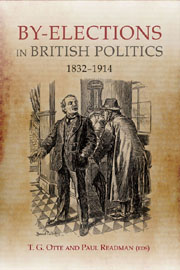Book contents
- Frontmatter
- Contents
- List of Figures and Tables
- List of Contributors
- Preface and Acknowledgements
- List of Abbreviations
- Introduction
- 1 ‘Plumping Contests’: The Impact of By-elections on English Voting Behaviour, 1790–1868
- 2 Government Appointment By-elections: 1832–86
- 3 ‘We should have had 1,000’: The By-elections of the 1874 Parliament
- 4 ‘The Glamour of Independence’: By-elections and Radicalism during the Liberal Meridian, 1869–83
- 5 ‘The Swing of the Pendulum at Home’: By-elections and Foreign Policy, 1865–1914
- 6 By-elections and the Modernisation of Party Organisation, 1867–1914
- 7 ‘A Terrific Outburst of Political Meteorology’: By-elections and the Unionist Electoral Ascendancy in Late-Victorian England
- 8 Land Reform and By-elections, 1885–1914: Do By-elections Matter?
- 9 Edwardian By-elections
- 10 Lloyd George, Limehouse and the Realignment of British Politics: The Bermondsey By-election of 1909
- 11 By-elections and the Peculiarities of Scottish Politics, 1832–1900
- Index of By-election Contests
- General Index
9 - Edwardian By-elections
Published online by Cambridge University Press: 05 May 2013
- Frontmatter
- Contents
- List of Figures and Tables
- List of Contributors
- Preface and Acknowledgements
- List of Abbreviations
- Introduction
- 1 ‘Plumping Contests’: The Impact of By-elections on English Voting Behaviour, 1790–1868
- 2 Government Appointment By-elections: 1832–86
- 3 ‘We should have had 1,000’: The By-elections of the 1874 Parliament
- 4 ‘The Glamour of Independence’: By-elections and Radicalism during the Liberal Meridian, 1869–83
- 5 ‘The Swing of the Pendulum at Home’: By-elections and Foreign Policy, 1865–1914
- 6 By-elections and the Modernisation of Party Organisation, 1867–1914
- 7 ‘A Terrific Outburst of Political Meteorology’: By-elections and the Unionist Electoral Ascendancy in Late-Victorian England
- 8 Land Reform and By-elections, 1885–1914: Do By-elections Matter?
- 9 Edwardian By-elections
- 10 Lloyd George, Limehouse and the Realignment of British Politics: The Bermondsey By-election of 1909
- 11 By-elections and the Peculiarities of Scottish Politics, 1832–1900
- Index of By-election Contests
- General Index
Summary
Historians have long evinced considerable interest in the Edwardian period, political historians perhaps more than most. Early work by filie Halevy and George Dangerfield established the fifteen or so years before the First World War as crucially transformative of British politics, featuring – inter alia – the efflorescence of pressure group agitation, the rise of the modern-day Labour movement, and deep political crisis for Liberalism. More recent research has offered illuminating interpretations of the politics of these tumultuous years, and stimulated intense scholarly debate on many issues, from the effectiveness of the suffragette campaign to the political significance of New Liberalism and the Radical Right. It should come as no surprise, therefore, that the electoral politics of this period have not escaped examination, with by-elections attracting their fair share of attention. The heavy involvement of pressure groups such as the Navy League in by-election contests has been analysed, as have the tactics of campaigners for women's suffrage. But perhaps most notably, by-elections provide heuristic tools for historians to investigate the emergence of the Labour party, as well as the broader questions of the emergence of three-party and class politics in Britain. They also offer the only hard psephological evidence on the much-debated question of the electoral strength of Liberalism before 1914.
- Type
- Chapter
- Information
- By-Elections in British Politics, 1832-1914 , pp. 227 - 250Publisher: Boydell & BrewerPrint publication year: 2013

